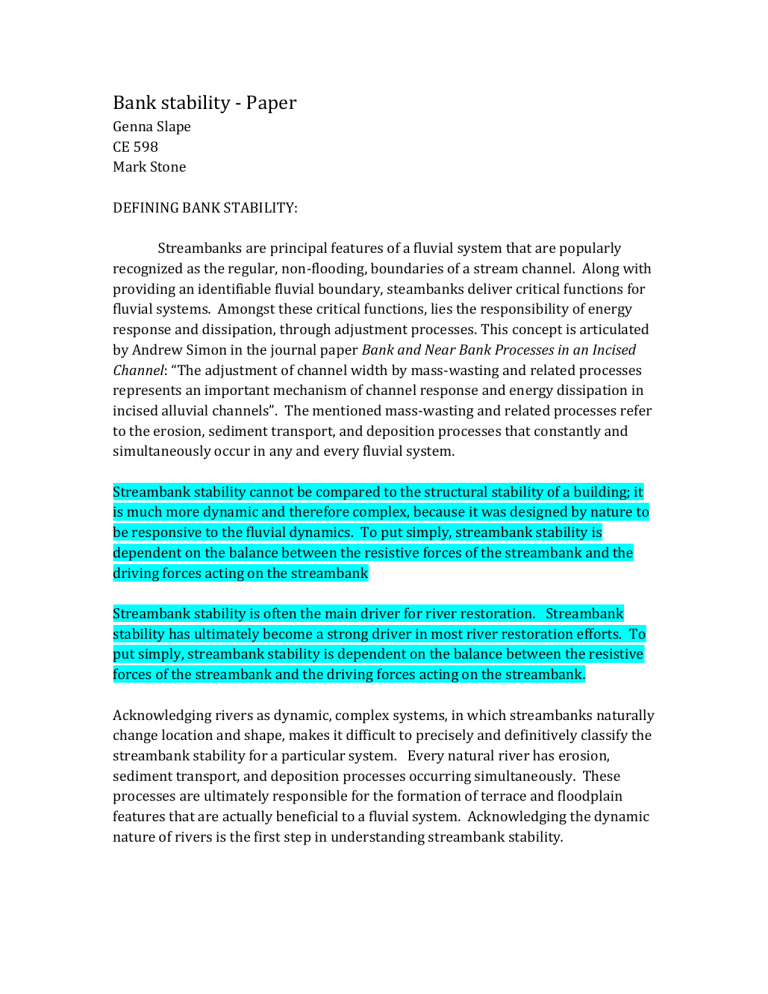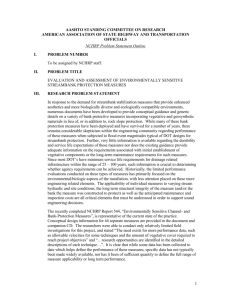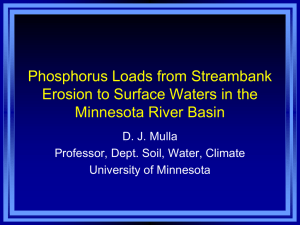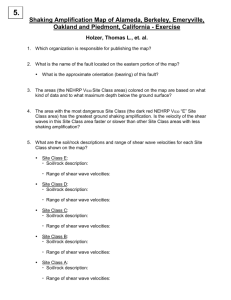Bank Stability 90%

Bank stability - Paper
Genna Slape
CE 598
Mark Stone
DEFINING BANK STABILITY:
Streambanks are principal features of a fluvial system that are popularly recognized as the regular, non-flooding, boundaries of a stream channel. Along with providing an identifiable fluvial boundary, steambanks deliver critical functions for fluvial systems. Amongst these critical functions, lies the responsibility of energy response and dissipation, through adjustment processes. This concept is articulated by Andrew Simon in the journal paper Bank and Near Bank Processes in an Incised
Channel: “The adjustment of channel width by mass-wasting and related processes represents an important mechanism of channel response and energy dissipation in incised alluvial channels”. The mentioned mass-wasting and related processes refer to the erosion, sediment transport, and deposition processes that constantly and simultaneously occur in any and every fluvial system.
Streambank stability cannot be compared to the structural stability of a building; it is much more dynamic and therefore complex, because it was designed by nature to be responsive to the fluvial dynamics. To put simply, streambank stability is dependent on the balance between the resistive forces of the streambank and the driving forces acting on the streambank
Streambank stability is often the main driver for river restoration. Streambank stability has ultimately become a strong driver in most river restoration efforts. To put simply, streambank stability is dependent on the balance between the resistive forces of the streambank and the driving forces acting on the streambank.
Acknowledging rivers as dynamic, complex systems, in which streambanks naturally change location and shape, makes it difficult to precisely and definitively classify the streambank stability for a particular system. Every natural river has erosion, sediment transport, and deposition processes occurring simultaneously. These processes are ultimately responsible for the formation of terrace and floodplain features that are actually beneficial to a fluvial system. Acknowledging the dynamic nature of rivers is the first step in understanding streambank stability.
In an attempt to understand bank stability, river experts have defined three classifications of stream stability: completely stable, dynamically stable, and unstable. This classification scheme ultimately depends on the streambank stability as the main cataloging indicator. Channelized, concrete lined streams are considered completely stable. In these types of systems, channel features such as streambanks, channel bed, and meanders are completely fixed in space and time.
Streams that run through bedrock are naturally occurring examples of completely stable streams.
Every fluvial system strives for an equilibrium state, which is confined by limiting thresholds that operate within the extent of a standard range of erosion and sediment deposition for a system. Channel Equilibrium is disrupted when aggragation and degradation which extends beyond the standard range of erosion and sediment deposition. Channel equilibrium is dependent on the balance of specific in-channel variables: sediment load, sediment size, channel flow, and channel slope. If one variable is subject to change the remaining variables must respond accordingly to re-establish the desired equilibrium state. If the in-channel variables are subjected to extensive changes that exceed the current allowable thresholds, the fluvial system may seek a new equilibrium state, confined by a new threshold. A system functioning within a specific threshold range is considered dynamically stable. This means that in a dynamically stable system, the locations of channel features such as streambanks, channel bed, and may be subject to change, but the general feature relations remain constant over time.
A channel is considered unstable when the system (aggradataion and degradation) thresholds have been exceeded and the system is then put into a transition stage where a new equilibrium is being established. In this unstable transition stage, major changes occur in channel width, depth and sinuosity occur in a relatively short period of time consisting of anywhere from days to years. Figures () illustrate the range of ,
Fluvial systems and fluvial geomorphology are responsive to driving influences.
Their level of response to these driving influences, ultimately depends on the characteristics distinct to each system.
Streambank stability is essentially influenced by the interaction of fluvial and geotechnical processes that are occurring within and at the streambank boundaries.
These interacting processes include:
Things that are considered to be driving or resisting forces on streambank stability are hydraulic and conteracting hydrostatic forces, pore pressure defined by moisture content within the streambank, and root reinforcement within the bank matrix (A.Simon, et al).
Streambank and toe-bank process:
When analyzing streambank and near bank processestreambank mechanics. The interaction of the gravitational forces acting on the in situ bank material and the hydraulic forces acting on the bank toe control streambank mechanics. For this reason incised, alluvial streambanks are prone to structural instability, also known as erosion. Incised streambanks consist of the in situ bank material and the banktoe. Figure ( ) shows a simplified cross-sectional view of an incised streambank.
As can be seen in the figure the bank toe acts as a protective base for the in situ bank material.
Figure () -
The various mechanisms of streambank erosion can be generally be classified as either scour or mass bank failure. Scouring involves the direct removal of the materials forming the channel bottom, bank-toe, and lower portion of the in situ bank that contributes to the wetted perimeter. Scouring is the result of the hydraulic shear stresses exerted by the streamflow on the channel boundaries. The wetted perimeter for a conceptual channel cross-section is illustrated in Figure ().
Figure 1 – (http://www.ess.co.at/MANUALS/WATERWARE/webreacheditor.html)
As scouring causes undercutting of the bank-toe to occur, the overlying in situ bank material will be subject to the increase in driving stresses. Mass bank failure occurs when the scouring of the bank-toe and the adjacent channel bed steepens
(increases the height and angle) of the bank to the point that the shear strength of the bank material can no longer resist the increased gravitational forces exceed the resistive shear strength of the bank material (Simon et al). The shear strength of the bank is dependent on two main factors:
First the nature of the bank material; specifically the bank stratification and the corresponding particle distributions, distinct to each stratum. The Mohr-Coulomb
failure criterion can be used to quantify the shear strength of the bank material
(Simon et al). The particle distribution of each layer ultimately determines the values of the input variables applied in the Mohr-Coulomb equation
Second the saturated conditions within the bank material. The polar attraction of water and mineral surfaces causes the water to spread and itself across these mineral surfaces The saturation within the bank matrix affects the shear strength of the bank material in two, conflicting ways. The degree of saturation within the bank mass dictates the confining pore water pressures. The first scenario, involves negative porewater pressures in unsaturated bank conditions, and contributes to the bank’s shear strength. Above the water table the pores are filled with water and air, creating an effect known as matric suction; this effect increases the shear strength of the bank. Oppositely positive pore water pressure,
The saturation conditions also contribute to the effect of gravitational forces acting on the bank material. Amplified saturation of streambank soils not only increases pore-water pressures, it also increases the soil unit weight. Weight is simply the measurement of the pull of gravitational forces acting on an object, therefore the more the bank weighs, the more likely mass failure will occur.
Mass failure is evident at points of a channel reach where large fragments of bank material are released from the channel bank formation. There are various types of mass bank failure mechanisms; the type failure that occurs reflects the degree of undercutting due to fluvial scouring, as well as the characteristics of the in situ bank material (Simon et al). Rotational, planar, and cantilever are the simplest forms of mass bank failure, and are illustrated in Figure 2. An observable, in-stream example of a cantilever bank is provided in Figure 3.
Figure 2 – Selection of observable mass bank failure types. (Simon et al. BSTEM)
Geotechnical Forces:
The balance of the internal resisting forces to the driving forces determines the stability of a streambank. Therefore to analyze bank stability it is necessary to understand the nature of shearing resistance, as well as to quantify it. The same understanding and calculation of the driving gravitational forces acting on the bank soil mass is necessary when analyzing bank stability. The shear strength of a soil mass is defined as the internal resistance per unit area that the soil mass can offer to resist failure and sliding along a plane inside it (Das), and is quantified by the Mohr-
Coulomb failure criterion (Equation 1). Oppositely, Equation 2 quantifies the driving gravitational force.
The resistant shear strength described in Equation 1 accounts for the effects of pore-water pressures in the soil mass. Above the water table, pores are filled with water and air. The negative pore-water pressures that develop as the result of this unsaturated effect is known as matrix suction, which is represented in as the soil has a hasThe The effects of matrix suction are described in 𝜏 𝑟
= 𝑐 ′ + (𝜎 − 𝑢 𝑎
)𝑡𝑎𝑛ϕ ′ + (𝑢 𝑎
− 𝑢 𝑤
)𝑡𝑎𝑛ϕ 𝑏 (Equation 1) 𝜎 = 𝑊 ∗ 𝑐𝑜𝑠𝛽 (Equation 1a) 𝜓 = 𝑢 𝑎 𝜏 𝑑
− 𝑢 𝑤
(Equation 1b)
= 𝜎 ∗ 𝑐𝑜𝑠𝛽 (Equation 2)
Where: 𝜏 𝑟
= shear strength(kPa) 𝜏 𝑑
= driving (gravitational) force (kPa) 𝜎 = normal stress on failure plane (kPa) 𝜑 = matric suction (kPa) 𝑐 ′ = effective cohesion (kPa) 𝑢 𝑎 𝑢 𝑤 ϕ ′
= air pressure (kPa)
= pore water pressure within the soil mass (kPa)
= effective friction angle (°) ϕ b = angle describing increase in τ r
due to increase in ψ (°)
The values of the effective cohesion, and effective friction angle are dependent on the particle distribution of the soil mass in question.
The ratio between the resisting forces and driving forces, describes the stability of a soil mass (streambank). This ratio (Equation 3) is defined as the factor of safety; the streambank is considered unstable when F s is less than one.
𝐹 𝑠
= 𝜏 𝜏 𝑟 𝑑
(Equation 3)
Hydraulic Forces:
In an incised channel bank heights are typically taller than the extending length of stabilizing Riparian roots and are highly vulnerable to erosion. Bank-toe erosion causes steepening of the bank profile and the potential for mass bank failure. In a storm event, during which channel flows are increasing, bank toe erosion generally occurs prior to the mass failure of the in-situ bank. Therefore the quantification of the hydraulic forces acting on the bank-toe, channel bed, and lower in-situ bank, is equally as important as calculating the geotechnical forces acting on the overlying in situ bank material and in understanding the bank failure processes.
The erodibility of the bank-toe region is dependent on the balance between the shear resistance of the bank-toe and the erosion driving, hydraulic forces applied to the channel boundary by the flow. The shear resistance of the bank-toe materials is called the critical shear stress. The applied hydraulic stresses vary with stream flow velocity, therefore they are not constant along a channel boundary at a particular cross-section. Equation 4 represents the erosive capability of the channel flow as the mean boundary shear stress: 𝜏
0
= 𝛾 𝑤
𝑅𝑆 𝑤
The shear resistance of the bank-toe material is called the critical shear stress
Vegetation:
Riparian vegetation has typically been seen as having a positive effect on streambank stability. However more studies are beginning to show that the presence of riparian vegetation induces hydrologic and hydraulic effects that have negative correlations on streambank stability. The effect of mechanical rootreinforcement on soil stability can be considerable
Riparian vegetation provides streambank stability through the mechanical effects of the plant foliage cover and the root networks found within the bank soil matrix. Vegetation growing along the bank-toe and lower bank regions protects these regions from hydraulic scouring by impeding channel flows; which reduce flow velocities, divert flows and ultimately reduce boundary drag forces. The effect of mechanical root-reinforcement on soil stability can be considerable. Streambank vegetation also provides root networks that provide scouring and mass bank failure resistance. Vegetated foliage varies temporally due to a number of environmental factors including temperature and available moisture. Times in which plant foliage does not cover streambanks, the extended root networks are still able to slow and divert channel flows; thus providing scouring protection for the lower bank-toe
region. In incised channels with excessive bank heights, root networks are not able to reach the lower bank regions, exposing the bank-toe to scouring effects. This ultimately causes deeper channel incision and higher potential for streambank failure.
Soil is strong in compression but weak in tension. Reversely, the roots of trees and other herbaceous species that may be present in a stream bank possess tensile resistance but lack compressive strength. Therefore roots provide the soil matrix the lacking tensile strength, and ultimately enhanced stability of streambank.
This enhanced tensile resistance provides resistance in the bank material against gravitational forces that increase as the bank-toe is eroded.
More recently the Streambank vegetation affects the hydrologic conditions within a streambank which can have a negative effect on streambank stability
Stabilizing Methods
Conclusion




